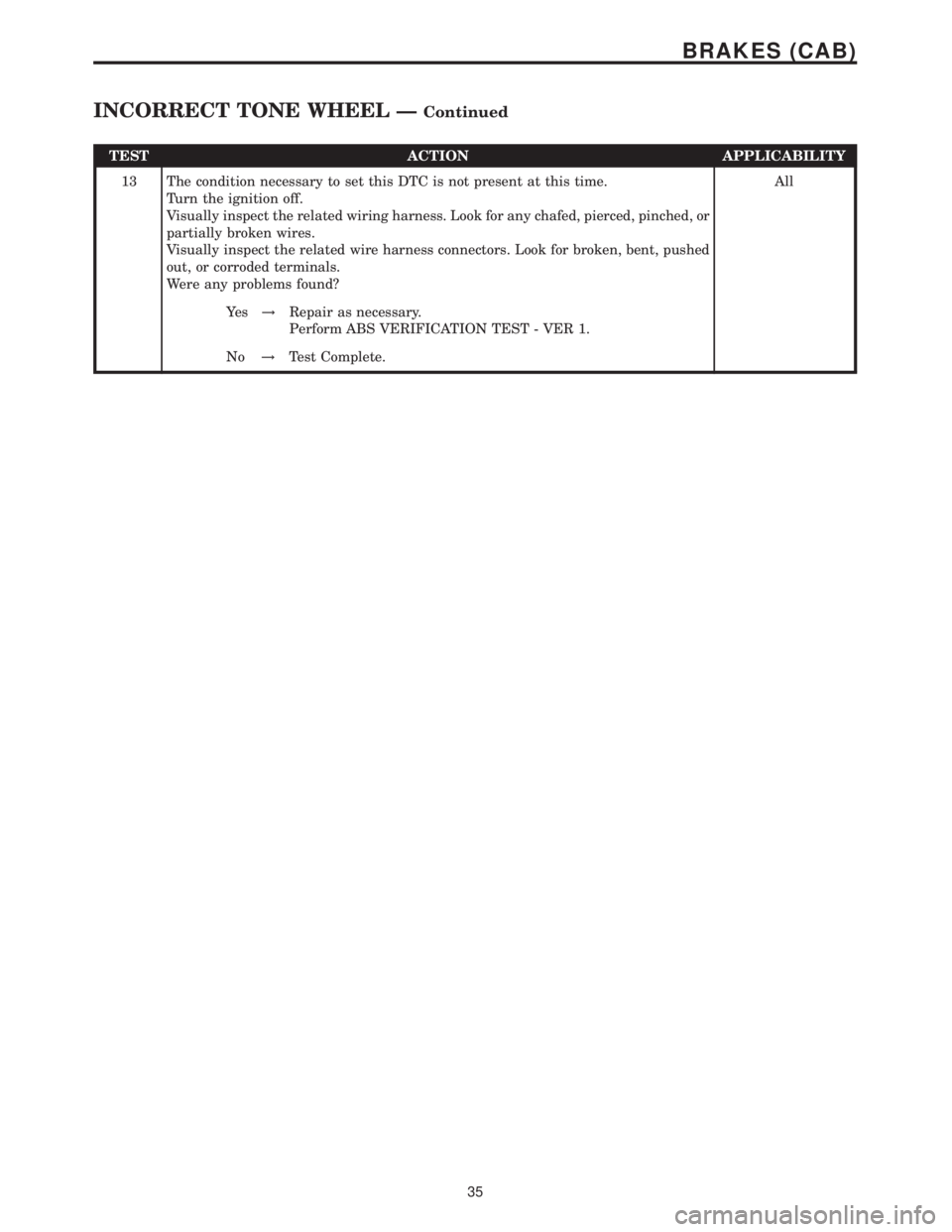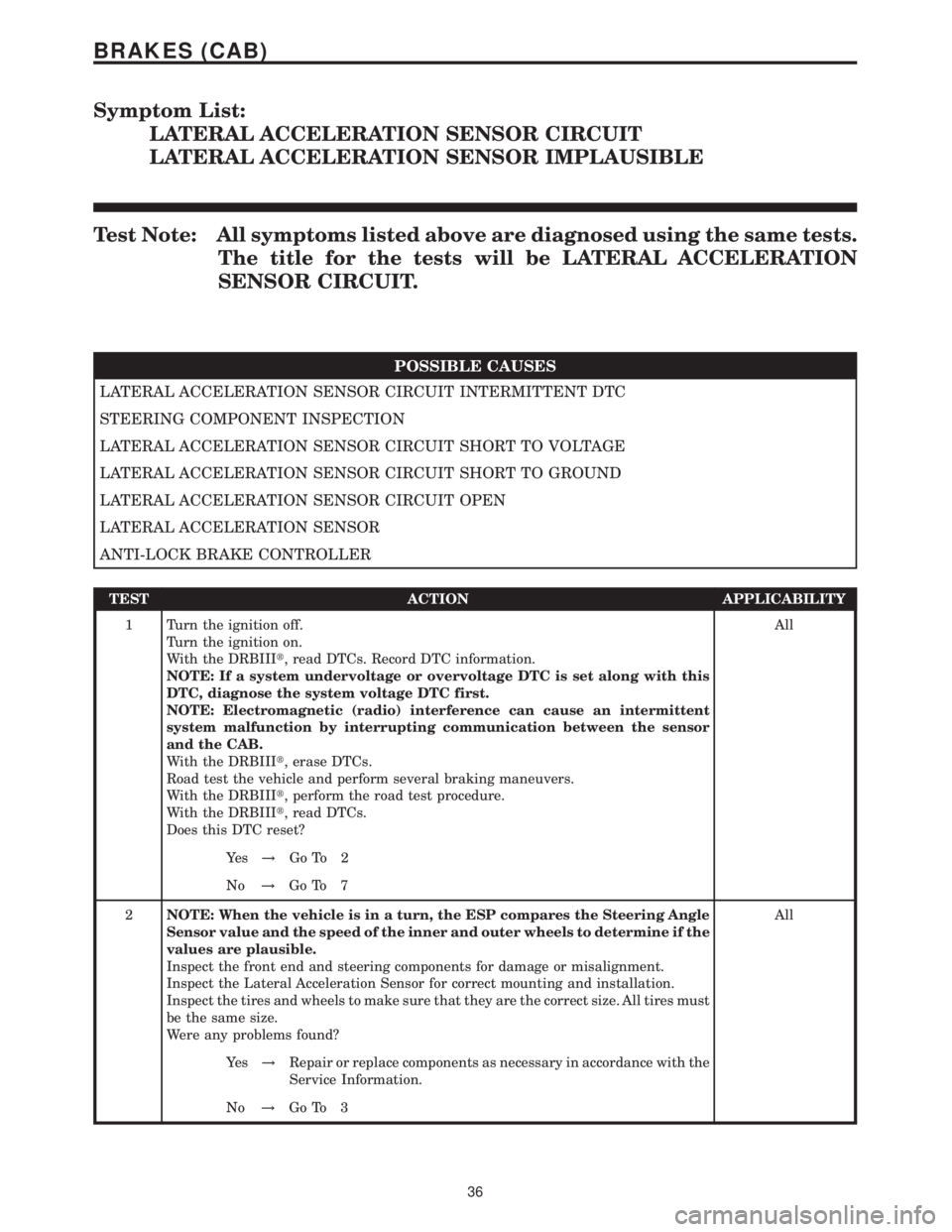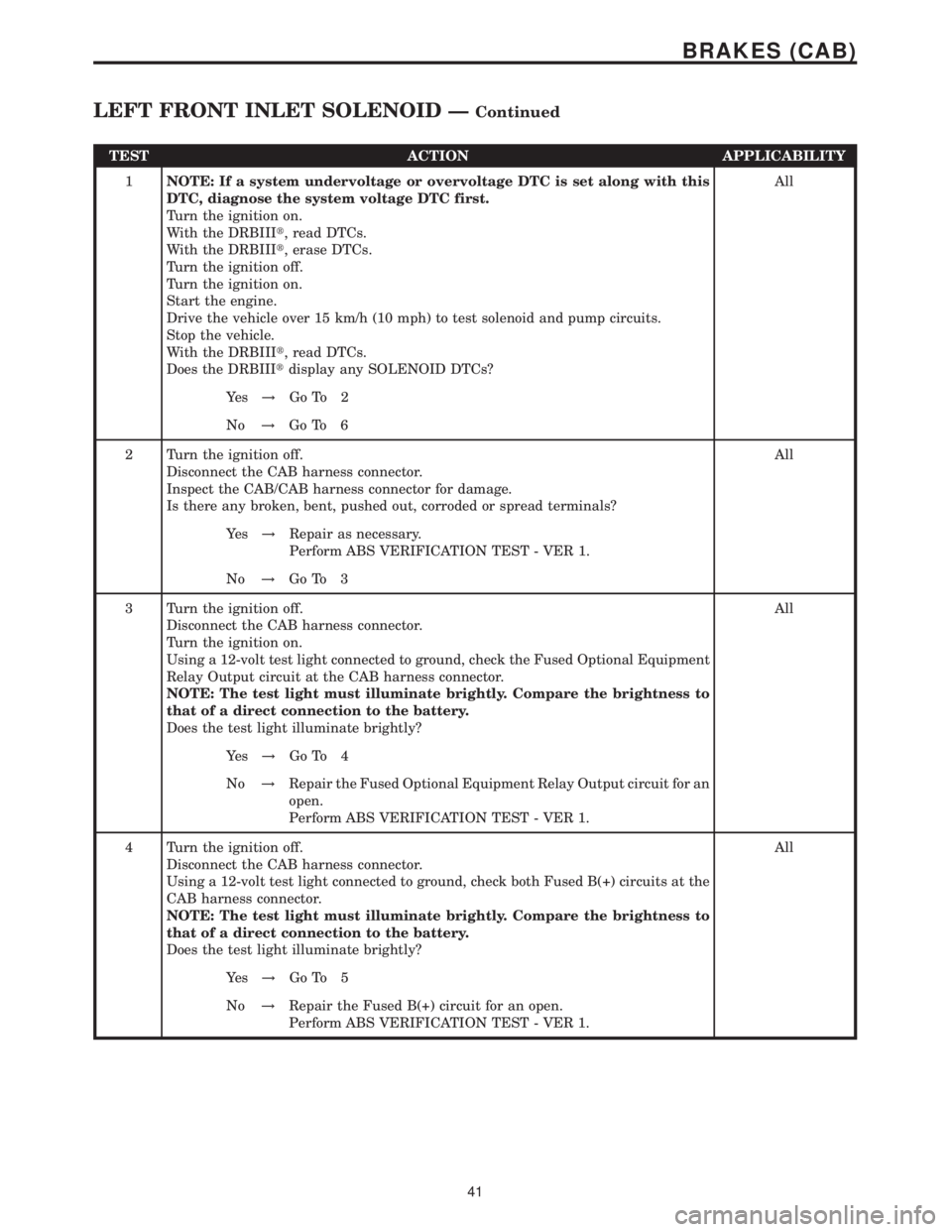2006 MERCEDES-BENZ SPRINTER ignition
[x] Cancel search: ignitionPage 354 of 2305

TEST ACTION APPLICABILITY
2 Turn the ignition off.
Inspect the tire sizes on the vehicle.
Is a smaller than production tire or spare tire being used?All
Ye s!Repair as necessary.
Perform ABS VERIFICATION TEST - VER 1.
No!Go To 3
3 Turn the ignition off.
Measure all the tire circumferences.
Do all the tire circumferences match?All
Ye s!Go To 4
No!Repair as necessary.
Perform ABS VERIFICATION TEST - VER 1.
4 Turn the ignition off.
Inspect the tone wheel(s) for damage, missing teeth, cracks, or looseness.
NOTE: Refer to the service manual information, if necessary, for procedures
or specifications.
Are one or more tone wheel(s) loose or damaged?All
Ye s!Repair as necessary.
Perform ABS VERIFICATION TEST - VER 1.
No!Go To 5
5 Turn the ignition off.
Inspect the wheel bearings for excessive runout or clearance.
NOTE: Refer to the service information, if necessary, for procedures or
specifications.
Is the wheel bearing clearance within specifications?All
Ye s!Go To 6
No!Repair as necessary.
Perform ABS VERIFICATION TEST - VER 1.
6 Turn the ignition off.
Visually inspect the brakes for locking up due to lining contamination or overheating.
Inspect all brake components for any condition that would cause a variation in wheel
speed.
Is any component damaged?All
Ye s!Repair as necessary.
Perform ABS VERIFICATION TEST - VER 1.
No!Go To 7
7 Turn the ignition on.
With the DRBIIItin Sensors, monitor ALL the Wheel Speed Sensor signals while an
assistant drives the vehicle.
Slowly accelerate from a stop to 65 km/h (40 mph).
NOTE: Wheel Speed should not vary by more than 10% from wheel to wheel
when driving in a straight line.
Do any of the Wheel Speed Sensor signals vary by greater than 10% while driving in
a straight line?All
Ye s!Go To 8
No!Go To 13
33
BRAKES (CAB)
INCORRECT TONE WHEEL ÐContinued
Page 355 of 2305

TEST ACTION APPLICABILITY
8 Turn the ignition off.
Disconnect the CAB harness connector.
Turn the ignition on.
Measure the voltage of both affected Wheel Speed Sensor circuits in the CAB harness
connector.
Is there any voltage present?All
Ye s!Repair the affected Wheel Speed Sensor circuit for a short to
voltage.
Perform ABS VERIFICATION TEST - VER 1.
No!Go To 9
9 Turn the ignition off.
Disconnect the CAB harness connector.
Measure the resistance between ground and both affected Wheel Speed Sensor
circuits in the CAB harness connector.
Is the resistance below 5.0 ohms?All
Ye s!Repair the affected Wheel Speed Sensor circuit for a short to
ground.
Perform ABS VERIFICATION TEST - VER 1.
No!Go To 10
10 Turn the ignition off.
Disconnect the CAB harness connector.
Measure the resistance between the affected Wheel Speed Sensor circuits in the CAB
harness connector.
Is the resistance over 1,800 ohms?All
Ye s!Repair the affected Wheel Speed Sensor circuit for an open.
Perform ABS VERIFICATION TEST - VER 1.
No!Go To 11
11 Turn the ignition off.
Disconnect the CAB harness connector.
Measure the resistance between the affected Wheel Speed Sensor circuits in the CAB
harness connector.
Is the resistance under 1,100 ohms?All
Ye s!Repair the affected Wheel Speed Sensor circuits for a short to
each other.
Perform ABS VERIFICATION TEST - VER 1.
No!Go To 12
12 Turn the ignition off.
Disconnect the CAB harness connector.
Measure the resistance between the affected Wheel Speed Sensor circuits in the CAB
harness connector.
Is the resistance between 1,100 and 1,800 ohms?All
Ye s!Go To 13
No!Replace the Wheel Speed Sensor in accordance with the Service
Information.
Perform ABS VERIFICATION TEST - VER 1.
34
BRAKES (CAB)
INCORRECT TONE WHEEL ÐContinued
Page 356 of 2305

TEST ACTION APPLICABILITY
13 The condition necessary to set this DTC is not present at this time.
Turn the ignition off.
Visually inspect the related wiring harness. Look for any chafed, pierced, pinched, or
partially broken wires.
Visually inspect the related wire harness connectors. Look for broken, bent, pushed
out, or corroded terminals.
Were any problems found?All
Ye s!Repair as necessary.
Perform ABS VERIFICATION TEST - VER 1.
No!Test Complete.
35
BRAKES (CAB)
INCORRECT TONE WHEEL ÐContinued
Page 357 of 2305

Symptom List:
LATERAL ACCELERATION SENSOR CIRCUIT
LATERAL ACCELERATION SENSOR IMPLAUSIBLE
Test Note: All symptoms listed above are diagnosed using the same tests.
The title for the tests will be LATERAL ACCELERATION
SENSOR CIRCUIT.
POSSIBLE CAUSES
LATERAL ACCELERATION SENSOR CIRCUIT INTERMITTENT DTC
STEERING COMPONENT INSPECTION
LATERAL ACCELERATION SENSOR CIRCUIT SHORT TO VOLTAGE
LATERAL ACCELERATION SENSOR CIRCUIT SHORT TO GROUND
LATERAL ACCELERATION SENSOR CIRCUIT OPEN
LATERAL ACCELERATION SENSOR
ANTI-LOCK BRAKE CONTROLLER
TEST ACTION APPLICABILITY
1 Turn the ignition off.
Turn the ignition on.
With the DRBIIIt, read DTCs. Record DTC information.
NOTE: If a system undervoltage or overvoltage DTC is set along with this
DTC, diagnose the system voltage DTC first.
NOTE: Electromagnetic (radio) interference can cause an intermittent
system malfunction by interrupting communication between the sensor
and the CAB.
With the DRBIIIt, erase DTCs.
Road test the vehicle and perform several braking maneuvers.
With the DRBIIIt, perform the road test procedure.
With the DRBIIIt, read DTCs.
Does this DTC reset?All
Ye s!Go To 2
No!Go To 7
2NOTE: When the vehicle is in a turn, the ESP compares the Steering Angle
Sensor value and the speed of the inner and outer wheels to determine if the
values are plausible.
Inspect the front end and steering components for damage or misalignment.
Inspect the Lateral Acceleration Sensor for correct mounting and installation.
Inspect the tires and wheels to make sure that they are the correct size. All tires must
be the same size.
Were any problems found?All
Ye s!Repair or replace components as necessary in accordance with the
Service Information.
No!Go To 3
36
BRAKES (CAB)
Page 358 of 2305

TEST ACTION APPLICABILITY
3 Turn the ignition off.
Disconnect the Lateral Acceleration Sensor harness connector.
Disconnect the CAB harness connector.
Turn the ignition on.
Measure the voltage on all 4 of the Lateral Acceleration Sensor signal circuits.
Measure the voltage of the Lateral Acceleration Sensor ground circuit.
There should be no voltage present on any of the circuits.
Measure the resistance between the Lateral Acceleration supply circuit and all 4 of
the Lateral Acceleration Sensor signal circuits.
The resistance between the circuits should be above 5.0 ohms.
Were there any problems found?All
Ye s!Repair the Lateral Acceleration Sensor circuit(s) for a short to
voltage.
No!Go To 4
4 Turn the ignition off.
Disconnect the Lateral Acceleration Sensor harness connector.
Disconnect the CAB harness connector.
Measure the resistance between the Lateral Acceleration Sensor ground and the 4
Lateral Acceleration Sensor signal circuits.
Measure the resistance between ground and the 4 Lateral Acceleration Sensor signal
circuits.
Measure the resistance between ground and the Lateral Acceleration Sensor supply
circuit.
Is the resistance below 5.0 ohms for any of the circuits?All
Ye s!Repair the Lateral Acceleration Sensor circuit(s) for a short to
ground.
No!Go To 5
5 Turn the ignition off.
Disconnect the Lateral Acceleration Sensor harness connector.
Disconnect the CAB harness connector.
Measure the resistance of the Lateral Acceleration Sensor supply circuit.
Measure the resistance of the Lateral Acceleration Sensor ground circuit.
Measure the resistance of the 4 Lateral Acceleration Sensor signal circuits.
Is the resistance above 5.0 ohms for any of the circuits?All
Ye s!Repair the Lateral Acceleration Sensor circuit(s) for an open
No!Go To 6
6 Turn the ignition off.
Disconnect the Lateral Acceleration Sensor harness connector.
Inspect the harness and connectors related to this circuit. If any problems are found,
repair as necessary.
If no problems are found, replace the Lateral Acceleration Sensor in accordance with
the Service Information.
With the DRBIIIt, clear DTCs.
With the DRBIIIt, perform the road test procedure.
With the DRBIIIt, read DTCs.
Does this DTC reset?All
Ye s!Replace the CAB in accordance with the Service Information.
No!Test Complete.
37
BRAKES (CAB)
LATERAL ACCELERATION SENSOR CIRCUIT ÐContinued
Page 360 of 2305

Symptom:
LATERAL ACCELERATION SENSOR INTERNAL FAULT
POSSIBLE CAUSES
LATERAL ACCELERATION SENSOR CIRCUIT INTERMITTENT DTC
LATERAL ACCELERATION SENSOR
TEST ACTION APPLICABILITY
1 Turn the ignition off.
Turn the ignition on.
With the DRBIIIt, read DTCs. Record DTC information.
NOTE: If a system undervoltage or overvoltage DTC is set along with this
DTC, diagnose the system voltage DTC first.
NOTE: Electromagnetic (radio) interference can cause an intermittent
system malfunction by interrupting communication between the sensor
and the CAB.
With the DRBIIIt, erase DTCs.
Road test the vehicle and perform several steering and braking maneuvers.
With the DRBIIIt, perform the road test procedure.
With the DRBIIIt, read DTCs.
Does this DTC reset?All
Ye s!Replace the Lateral Acceleration Sensor in accordance with the
Service Information.
No!Go To 2
2 The condition that set this DTC is not present at this time.
Monitor the DRBIIItwhile wiggle testing the related harness and connectors. Look
for any related parameters to change or for the DTC to reset.
Inspect the related harness and connectors.
Look for any chafed, pierced, pinched, or partially broken wires.
Look for broken, bent, pushed out, or corroded terminals.
Were any problems found?All
Ye s!Repair as necessary.
No!Test Complete.
39
BRAKES (CAB)
Page 361 of 2305

Symptom List:
LEFT FRONT INLET SOLENOID
LEFT FRONT OUTLET SOLENOID
LEFT FRONT, RIGHT REAR INLET SOLENOID
LEFT FRONT, RIGHT REAR OUTLET SOLENOID
LEFT REAR INLET SOLENOID
LEFT REAR OUTLET SOLENOID
RIGHT FRONT INLET SOLENOID
RIGHT FRONT OUTLET SOLENOID
RIGHT FRONT, LEFT REAR INLET SOLENOID
RIGHT FRONT, LEFT REAR OUTLET SOLENOID
RIGHT REAR INLET SOLENOID
RIGHT REAR OUTLET SOLENOID
Test Note: All symptoms listed above are diagnosed using the same tests.
The title for the tests will be LEFT FRONT INLET SOLE-
NOID.
When Monitored and Set Condition:
LEFT FRONT INLET SOLENOID
When Monitored: Ignition On - Continuousy
Set Condition: When the electrical feedback signal does not match the actuation signal
for the solenoid OR during the solenoid and pump motor test when all solenoids are tested
in series and a solenoid response signal is detected.
POSSIBLE CAUSES
INTERMITTENT SOLENOID DTC
DAMAGED CAB/CAB HARNESS CONNECTOR
FUSED OPTIONAL EQUIPMENT RELAY OUTPUT CIRCUIT OPEN
FUSED B(+) CIRCUIT OPEN
GROUND CIRCUIT OPEN
ANTI-LOCK BRAKE CONTROLLER
40
BRAKES (CAB)
Page 362 of 2305

TEST ACTION APPLICABILITY
1NOTE: If a system undervoltage or overvoltage DTC is set along with this
DTC, diagnose the system voltage DTC first.
Turn the ignition on.
With the DRBIIIt, read DTCs.
With the DRBIIIt, erase DTCs.
Turn the ignition off.
Turn the ignition on.
Start the engine.
Drive the vehicle over 15 km/h (10 mph) to test solenoid and pump circuits.
Stop the vehicle.
With the DRBIIIt, read DTCs.
Does the DRBIIItdisplay any SOLENOID DTCs?All
Ye s!Go To 2
No!Go To 6
2 Turn the ignition off.
Disconnect the CAB harness connector.
Inspect the CAB/CAB harness connector for damage.
Is there any broken, bent, pushed out, corroded or spread terminals?All
Ye s!Repair as necessary.
Perform ABS VERIFICATION TEST - VER 1.
No!Go To 3
3 Turn the ignition off.
Disconnect the CAB harness connector.
Turn the ignition on.
Using a 12-volt test light connected to ground, check the Fused Optional Equipment
Relay Output circuit at the CAB harness connector.
NOTE: The test light must illuminate brightly. Compare the brightness to
that of a direct connection to the battery.
Does the test light illuminate brightly?All
Ye s!Go To 4
No!Repair the Fused Optional Equipment Relay Output circuit for an
open.
Perform ABS VERIFICATION TEST - VER 1.
4 Turn the ignition off.
Disconnect the CAB harness connector.
Using a 12-volt test light connected to ground, check both Fused B(+) circuits at the
CAB harness connector.
NOTE: The test light must illuminate brightly. Compare the brightness to
that of a direct connection to the battery.
Does the test light illuminate brightly?All
Ye s!Go To 5
No!Repair the Fused B(+) circuit for an open.
Perform ABS VERIFICATION TEST - VER 1.
41
BRAKES (CAB)
LEFT FRONT INLET SOLENOID ÐContinued